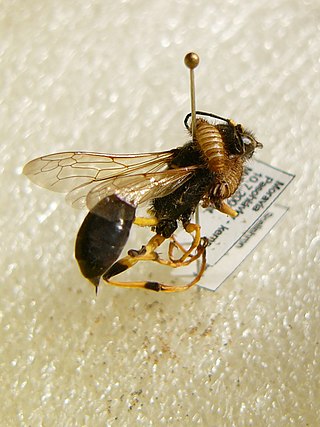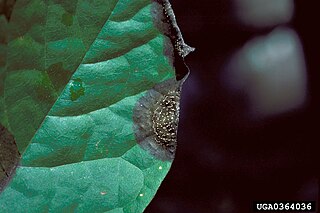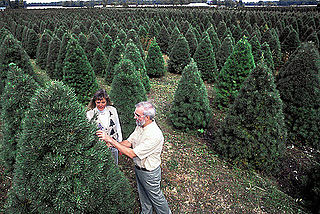
Biological control or biocontrol is a method of controlling pests, whether pest animals such as insects and mites, weeds, or pathogens affecting animals or plants by using other organisms. It relies on predation, parasitism, herbivory, or other natural mechanisms, but typically also involves an active human management role. It can be an important component of integrated pest management (IPM) programs.

A pest is any organism harmful to humans or human concerns. The term is particularly used for creatures that damage crops, livestock, and forestry or cause a nuisance to people, especially in their homes. Humans have modified the environment for their own purposes and are intolerant of other creatures occupying the same space when their activities impact adversely on human objectives. Thus, an elephant is unobjectionable in its natural habitat but a pest when it tramples crops.

Beauveria bassiana is a fungus that grows naturally in soils throughout the world and acts as a parasite on various arthropod species, causing white muscardine disease; it thus belongs to the group of entomopathogenic fungi. It is used as a biological insecticide to control a number of pests, including termites, thrips, whiteflies, aphids and various beetles. Its use in the control of bedbugs and malaria-transmitting mosquitos is under investigation.
A biopesticide is a biological substance or organism that damages, kills, or repels organisms seen as pests. Biological pest management intervention involves predatory, parasitic, or chemical relationships.

An entomopathogenic fungus is a fungus that can kill or seriously disable insects.

Bordeaux mixture (also called Bordo Mix) is a mixture of copper(II) sulphate (CuSO4) and quicklime (CaO) used as a fungicide. It is used in vineyards, fruit-farms and gardens to prevent infestations of downy mildew, powdery mildew and other fungi. It is sprayed on plants as a preventive treatment; its mode of action is ineffective after a fungus has become established. It was invented in the Bordeaux region of France in the late 19th century. If it is applied in large quantities annually for many years, the copper in the mixture eventually becomes a pollutant. As such its use is illegal in most of the European Union. Despite this, it has been promoted as an 'organic' pesticide.

Alternaria is a genus of Deuteromycetes fungi. All species are known as major plant pathogens. They are also common allergens in humans, growing indoors and causing hay fever or hypersensitivity reactions that sometimes lead to asthma. They are present in the human mycobiome and readily cause opportunistic infections in immunocompromised people such as AIDS patients.

Colletotrichum acutatum is a plant pathogen and endophyte. It is the organism that causes the most destructive fungal disease, anthracnose, of lupin species worldwide. It also causes the disease postbloom fruit drop on many varieties of citrus, especially Valencia and navel oranges in Florida.
Septoria ampelina is a fungal plant pathogen that affects grapes causing septoria leaf spot.
Septoria citri is a fungal plant pathogen infecting citruses.

Puccinia purpurea is a fungal species and plant pathogen that causes rust on sorghum. It is found in temperate places worldwide, excluding colder parts such as Russia and Canada.
Mycosphaerella eumusae is a fungal disease of banana, causing Eumusae leaf spot. Its symptoms are similar to black leaf streak. M. eumusae is the predominant Mycospharella of banana in mainland Malaysia and in Thailand, and is present in Mauritius and Nigeria. Septoria eumusae is an anamorph of Mycosphaerella eumusae.

Pine and fir trees, grown purposely for use as Christmas trees, are vulnerable to a wide variety of pests, weeds and diseases. Many of the conifer species cultivated face infestations and death from such pests as the balsam woolly adelgid and other adelgids. Aphids are another common insect pest. Christmas trees are also vulnerable to fungal pathogens and their resultant illnesses such as root rot, and, in the U.S. state of California, sudden oak death. Douglas-fir trees in particular are vulnerable to infections from plant pathogens such as R. pseudotsugae.

Ostrinia is a genus of moths in the family Crambidae described by Jacob Hübner in 1825. Several of them, including the European corn borer, are agricultural pests.

Passiflora arborea is a species of passion flower found in Colombia, Ecuador and Panama. Passiflora arborea is a freestanding tree that can grow to be 50 feet tall. They germinate anywhere from an elevation of 1400 – 2000 ft. The tree's leaves grow to be 1 to 1½ feet long. It is native to Colombia, is rarely seen in cultivation, and is one of two species of Passiflora that is not widely distributed throughout the country.
Forest pathology is the research of both biotic and abiotic maladies affecting the health of a forest ecosystem, primarily fungal pathogens and their insect vectors. It is a subfield of forestry and plant pathology.

The fungi imperfecti or imperfect fungi are fungi which do not fit into the commonly established taxonomic classifications of fungi that are based on biological species concepts or morphological characteristics of sexual structures because their sexual form of reproduction has never been observed. They are known as imperfect fungi because only their asexual and vegetative phases are known. They have asexual form of reproduction, meaning that these fungi produce their spores asexually, in the process called sporogenesis.
Integrated pest management in museums, libraries, archives and private collections is the practice of monitoring and managing pest and environmental information with pest control methods to prevent pest damage to collections and cultural property. Preserving cultural property is the ultimate goal for these institutions. The pests come in many different forms: insects, mites, rodents, bats, birds, and fungi and the two most common types are insects and fungi. It is widely recommended that every museum have some form of pest control in place and monitoring system to protect their collection and that museums review their storage and museum facilities to determine how to best control and prevent pest infestations while utilizing an Integrated Pest Management plan.
Black point is often considered a fungal disease that affects wheat, barley and rye. It is thought to be caused by various species of Alternaria, Fusarium, and Helminthosporium, and possibly other fungal genera. The fungus forms after the seeds have set but while they are still green and it is potentiated by high humidity. Infected areas are brown to black in color, and as the disease spreads the kernels may become shriveled. Occasionally the infected areas have a reddish tinge.
Sclerotinia bulborum is a plant pathogen infecting the bulbs of plants, causing black slime disease. It affects a number of ornamental bulbous plants including Iris, Hyacinth, Muscari and Narcissus.










